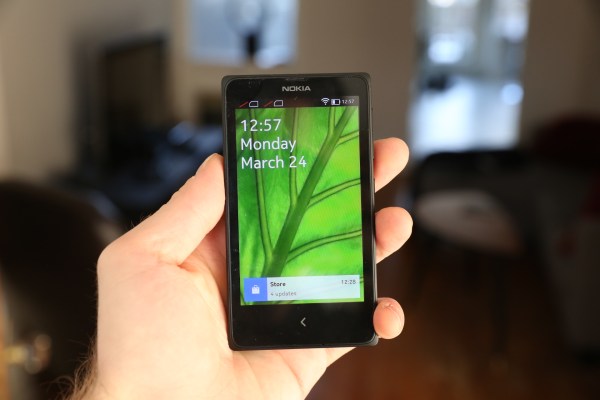Nokia’s weird foray into Android is the Nokia X, a small, affordable smartphone that uses Google’s mobile OS, painted up as though it were almost a Windows Phone software variant. It’s a strange beast, with a chunky candybar design that blatantly screams ‘Nokia,’ and a price tag aimed at emerging markets. There’s a good chance Microsoft will kill it as soon as it takes over Nokia’s hardware business (now set for April) but in the meantime, does the Nokia X offer users a way to claw back some of the market share they’ve given up to low-cost Android devices?
Basics
- 4-inch, 800×480 display
- 3MP rear camera
- Qualcomm Snapdragon S4 dual-core 1GHz processor
- 512MB RAM, 4GB on board storage
- Up to 32GB expandable storage via micro SD
- 28 days standby battery, 10.5 hours talk time , 4.5 hours web browsing time
- Price: Roughly $120-140 US off contract
- Product info page
Pros
- Light, cheap and effective
Cons
- Sluggish OS and web navigation
Design
The Nokia X isn’t fancy, but it’s also not a bad-looking device by any means. It resembles many of other Nokia devices, with defined edges and a thicker case, plus a polycarbonate back that’s matte and smooth to the touch. The case manages to feel like a single-piece design despite the fact that the back is removable because the phone itself pops out from the wraparound cover, instead of having just simple back panel that snaps on and off like on similar phones from Samsung.
[gallery ids="977128,977129,977130,977131,977132,977133,977134"]
The Nokia X comes in a variety of colors, and as Nokia is prone to do, it executes well on the brighter range of the spectrum. The black version I managed to get my hands on is also good looking, though much more understated than its candy-coated cousins.
A weird feature of Nokia’s take on Android is the single capacitive button it uses, which is simply a back command. This is kind of like a Home button, but contextually aware, so that it goes back a screen no matter where you are, with exiting an app being the final step in any chain. Pressing it on the home screen brings up a Windows Phone-like linear list of recently opened apps, too.
The home screen itself takes cues from Windows Phone, with icons arranged in a tile-like multicolored array. The icons can be adjusted and reconfigured, and set to take up either a 2×2 or 1×1 spot in the grid, and there are widgets accessible to the home screen, too, including ones specific to Nokia and standard Android ones built into third-party apps. It’s a different take on Android to be sure, and a far cry from a stock experience, but it’s also a system that I find far preferable to most other OEM UI reconfigurations, including Samsung Touchwiz.
Performance
This phone isn’t the most cracking handset on the block, and if you’re used to a top-end device like the iPhone or latest Galaxy S, you’re going to notice sluggishness, especially when browsing media-rich content and websites, or even a homescreen with a lot of icons. But overall, the experience does alright with limited resources, and never manages to become genuinely frustrating.
In terms of the field of devices against which it competes (those in the $100 range off-contract), it’s much more of a standout, offering more than competent access to Facebook, the native web, Twitter and other Android standbys in a package that’s both slick and affordable.
The dual-sim Nokia X also offers the ability to change easily between networks, and it has tremendous stand-by battery life. You can have the thing idle for weeks at a time and it’ll still be ready to go when you need it, which is a key concern in markets where access to power might not always be possible. If you’re using the cellular network constantly, battery life dips quickly and falls far short of either the iPhone or any other flagship Android device, but for infrequent use, the Nokia X outperforms either.
One more really nice thing about the Nokia X: Notifications on the custom home screen, including a text-based summary. It’s something that’s still missing from stock Android, and it’s a welcome addition to this custom fork.
Bottom Line
The Nokia X is a surprising bit of hardware, if you can put aside top-tier smartphone expectations and take it for what it is. It’s a good take on Android, and one that actually seeks to improve the experience, in addition to acting as a funnel for Microsoft’s line of mobile software and services. It might not be long for this world, but it also certainly doesn’t feel like a last-minute move Nokia made casually to just try a low-cost Android device before ceding its hardware business to Microsoft, either.
